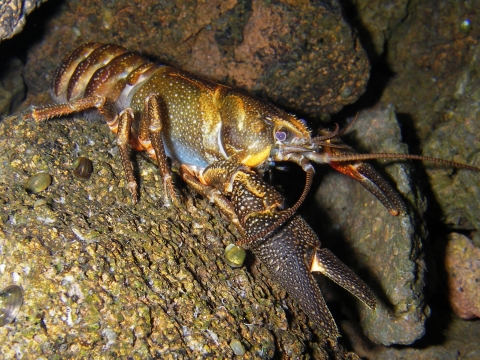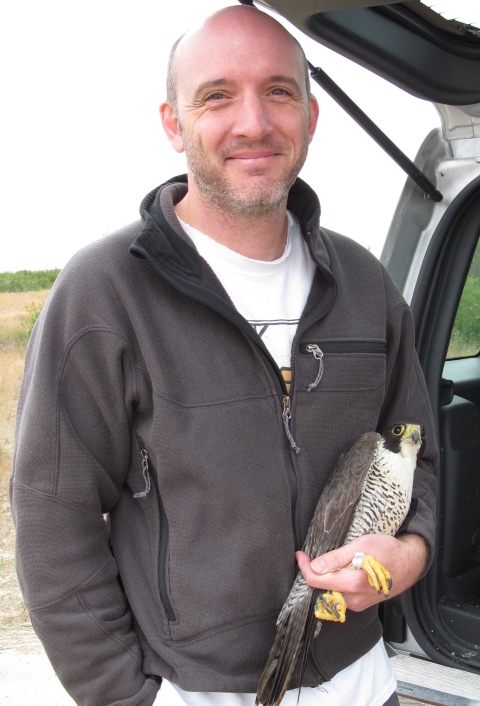Marin County’s landscape is a source of inspiration for many people, including Josh Hull, a Marin County native who now works for the U.S. Fish and Wildlife Service. “I’ve always loved nature because I was always in it,” he said. “I spent my weekends at Marin County beaches or in Muir Woods. It was an era where these places were well-known but not overcrowded.”
Today, Hull applies his passion to recovering endangered and threatened species in California, including the Shasta crayfish.
Living in cold streams fed by underground springs, the Shasta crayfish is California’s last native crayfish. Listed as endangered by the U.S. Fish and Wildlife Service in 1988, populations of the once prolific crayfish have declined over the past 20 years to the point where only about 500 individuals remain. But a project jointly developed by the U.S. Fish and Wildlife Service, the California Department of Fish and Wildlife, Spring Rivers Ecological Sciences, and the Pacific Gas and Electric Company could change the fate of the crayfish.
Shasta crayfish are found in rocky streambeds in groups of males and females of all ages. Unfortunately, they have been driven to near extinction by invasive signal crayfish that are more aggressive, reproduce at much higher rates and outcompete the Shasta crayfish for food and habitat.
“Only about 10 populations exist in the wild today, and there’s no captive breeding,” said Hull, who leads the Sacramento field office’s listing and recovery division.
Since 2010, Hull has represented the Service in the multi-partner working group with CDFW, PG&E and Spring Rivers Ecological Sciences. The group aims to find new solutions to recovering the crayfish’s populations.
“There’s been several efforts to try to reduce signal crayfish in the Shasta crayfish’s habitat, including electrofishing and stream barriers, but nothing has worked,” explained Hull. What the crayfish needed was a fresh start.
That fresh start came in the form of a meadow creek and a piped water diversion that directed water from a remote creek to a trout hatchery managed by CDFW. The working group developed a plan to relocate the diversion downstream and restore the existing meadow creek that had been dry since the 1950s. The restored creek would serve as the new home for the Shasta crayfish.
“This channel was isolated for 60 to 70 years, so there were no invasive crayfish present, the water was cold and the downstream barriers would prevent invasive crayfish from moving in,” said Hull.
The group developed a plan that helped deliver water to the hatchery while the restoration of the creek took place. The straight and narrow channel was restored to into a natural, meandering creek. Large rocks and natural lava gravel found nearby were placed into the creek to serve as habitat for the crayfish. The diversion structure was moved downstream to continue providing a clean water supply to the hatchery. Further downstream, existing barriers would continue to prevent signal crayfish from coming upstream.
“The rocks needed to be big enough for the crayfish to live under, easy enough for humans to lift, but tough for predators like raccoons to move,” described Hull. “Plants and worms that feed the crayfish live on the rocks, so we had to make sure the creek was watered long enough to allow for this food source to establish.”
In July 2019, the restoration was complete, and the creek was ready to get its Shasta crayfish residents.
“It was an incredibly hot day, but the water was so cold that the biologists placing the crayfish in the water had to wear full drysuits with fleece liners underneath,” said Hull. The water in the creek is about 51 degrees even at the peak of summer.
Spring Rivers Ecological Sciences moved 28 individuals from a nearby colony into the new creek. The individuals varied in size and provided a good mix of males and females to support breeding. Once released into the water, they quickly found the rock “condos” and adjusted to their new home.
Biologists returned to the creek in December to check on the crayfish. During a brief, 15-minute survey, more than 10 percent of the crayfish were found. This quick discovery gave them confidence that the crayfish were doing just fine. Plans are underway to translocate more individuals to the restored creek with the goal of having 100 Shasta crayfish established there.
“This project could help prevent an extinction,” said Hull. “While getting here was hard, there are a lot of good people working on this effort to recover the Shasta crayfish, and that gives me hope for the future of this species.”
Hull’s work to recover Shasta crayfish populations is just one of many recovery efforts that he’s working on.
“One thing that’s really fun for me is going back to Marin County, to places I went to when I was young, and seeing them in a completely new way,” he said.
In addition to the crayfish, Hull works with biologists in the Sacramento Field Office who are leading projects with Marin County Parks to recover five endangered plants on Ring Mountain, including a reintroduction of showy clover. He and the biologists are also working with the Golden Gate National Recreation Area to reintroduce Mission blue butterflies to the landscape and with Pt. Reyes National Seashore on endangered plant reintroductions.
“Conservation isn’t something that starts and ends,” he said. “The work I’m doing today is part of a longer history of conservationists, and I’m proud to be part of their legacy.”






